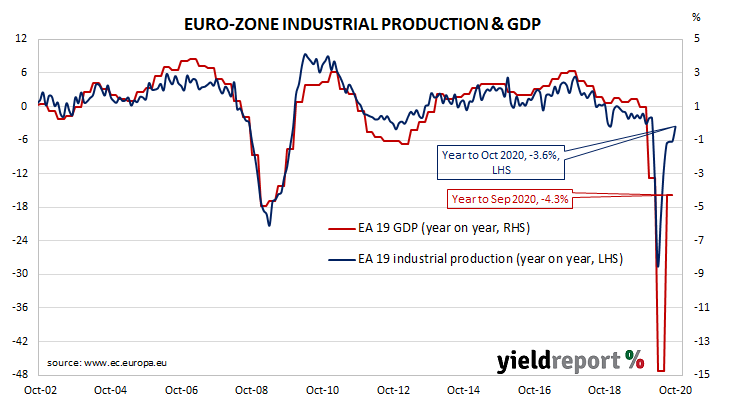Summary: Euro-zone industrial production jumps in October; monthly figure slightly higher than consensus estimate; annual rate still negative; “manufacturing “outperforming in uneven recovery”; German, French, Spanish, Italian production all expand.
Following a recession in 2009/2010 and the debt-crisis which flowed from it, euro-zone industrial production recovered and then reached a peak four years later in early 2016. Growth rates then fluctuated through 2016/2017 before beginning a steady and persistent slowdown from the start of 2018. That decline was transformed into a plunge in March and April but the months which followed produced an almost-equally steep bounce.
According to the latest figures released by Eurostat, euro-zone industrial production jumped on a seasonally-adjusted basis by 2.1% in October. The rise was slightly higher than the 1.8% increase which had been generally expected and significantly above September’s revised figure of 2.1%. On an annual basis, the seasonally-adjusted growth rate increased from September’s revised rate of -6.2% to -3.6%*.

German and French 10-year sovereign bond yields moved slightly higher on the day. By the close of business, the German 10-year bund yield had gained 2bps to -0.62% while the French 10-year OAT yield had inched up 1bp to -0.37%.
ANZ senior economist Felicity Emmett said the improvement in the annual growth rate “shows manufacturing is outperforming in the uneven recovery.” She also noted “investment demand may be showing some early green shoots” while a 2.1% rise in intermediate goods production implied “an ongoing recovery in trade.”
Industrial production growth expanded in all four of the euro-zone’s largest economies. Germany’s production grew by 3.4% in October while the comparable figures for France, Spain and Italy were 1.7%, 1.3% and 0.6% respectively.
As with other countries’ measures of industrial production, Eurostat’s industrial production index measures the output and activity of industrial sectors in euro-zone countries on aggregate.
* Eurostat’s published annual growth figures are calculated using index figures which are “calendar adjusted”, not “seasonally adjusted”. The published Eurostat figure was -3.8%.

